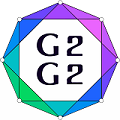Speaker
Description
We use mainly standard notation and terminology (see [1]). Let $G$ be a finite group. Denote by $\pi(G)$ the set of all prime divisors of the order of $G$ and by $\omega (G)$ the spectrum of $G$, i.e. the set of all its element orders. The set $\omega(G)$ defines the Gruenberg–Kegel graph (or the prime graph) $\Gamma(G)$ of $G$; in this simple graph the vertex set is $\pi(G)$, and distinct vertices $p$ and $q$ are adjacent if and only if $pq\in\omega (G)$.
The problem of description of the cases when Gruenberg–Kegel graphs of non-isomorphic finite groups coincide naturally arises. One of the most interesting cases of this problem is when Gruenberg–Kegel graphs of non-isomorphic finite groups are both disconnected and coincide.
Recall some known definitions. A finite group $G$ is a Frobenius group if there is a non-trivial subgroup $C$ of $G$ such that $C \cap gCg^{-1} = \{1\}$ whenever $g \not \in C$. A subgroup $C$ is a Frobenius complement of $G$. Let $K=\{1\} \cup (G\setminus \bigcup_{g \in G} gCg^{-1}).$ Then $K$ is a normal subgroup of a Frobenius group $G$ with a Frobenius complement $C$ which is called the Frobenius kernel of $G$. A finite group $G$ is a $2$-Frobenius group if $G=ABC$, where $A$ and $AB$ are normal subgroups of $G$, $AB$ and $BC$ are Frobenius groups with kernels $A$ and $B$ and complements $B$ and $C$, respectively. It is known that each $2$-Frobenius group is solvable. The socle $Soc(G)$ of a finite group $G$ is the subgroup of $G$ generated by the set of all its non-trivial minimal normal subgroups. A finite group $G$ is almost simple if $Soc(G)$ is a finite nonabelian simple group.
By the Gruenberg–Kegel Theorem, if $G$ is a finite group with disconnected Gruenberg–Kegel graph, then either $G$ is a Frobenius group or either $G$ is a $2$-Frobenius group or $G$ is an extension of a nilpotent group by an almost simple group. In [2] all the cases of coincidence of Gruenberg–Kegel graphs of a finite simple group and of a Frobenius or a $2$-Frobenius group were described. Moreover, we can obtain the complete list of almost simple groups whose Gruenberg–Kegel graphs coincide with Gruenberg–Kegel graphs of solvable Frobenius groups or $2$-Frobenius groups directly from the main results of the papers [3] and [4].
In this talk we concentrate on a list of almost simple (but not simple) groups whose Gruenberg–Kegel graphs coincide with Gruenberg–Kegel graphs of non-solvable Frobenius groups. We prove the following theorem.
Theorem 1. Let $G$ be an almost simple but not simple group. If $\Gamma(G) = \Gamma(H)$, where $H$ is a non-solvable Frobenius group, then either $G$ is one of the groups $Aut(M_{12})$, $S_7$, $Aut(^2F_4(q))$, $Aut(PSU_4(2))$, $L_3(4).2_3$, $PSL_4(3).{2_2}$, $PSL_4(3).{2_3}$, $PSL_2(11).2 \cong PGL_2(11)$, $PSL_2(19).2 \cong PGL_2(19)$, $PGL_2(49).{2_1}\cong PGL_2(49)$, $PSL_2(25).{2_2}$, $PSL_2(81).{2_1}$, $PSL_2(81).{4_1}$, $PSL_2(81).{4_2}$; or $Soc(G) \in \{PSL_3(q), PSU_3(q)\}$.
Acknowledgments. The work has been supported by the Russian Science Foundation (project 19-71-10067). This is joint work with Natalia Maslova.
[1] J.H. Conway, R.T. Curtis, S.P. Norton, R.A. Parker, R.A. Wilson, Atlas of finite groups, Clarendon Press, Oxford (1985).
[2] M.R. Zinov'eva, V.D. Mazurov, On finite groups with disconnected prime graph, Proc. Steklov Inst. Math. 283:S1 (2013) 139–145.
[3] I.B. Gorshkov, N.V. Maslova, Finite almost simple groups whose Gruenberg–Kegel graphs are equal to the Gruenberg–Kegel graphs of solvable groups, Algebra and Logic. 57:2 (2018) 115–129.
[4] M.R. Zinov'eva, A.S. Kondrat'ev, Finite almost simple groups with prime graphs all of whose connected components are cliques, Proc. Steklov Inst. Math. 295:S1 (2013) 178–188.

